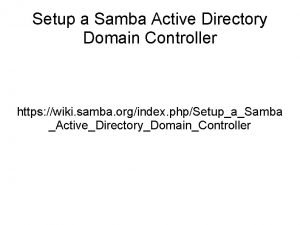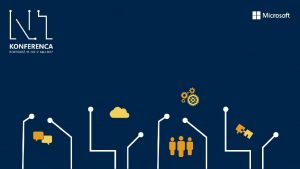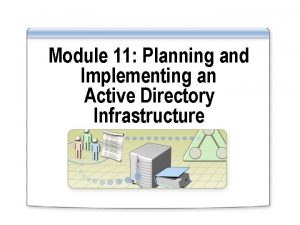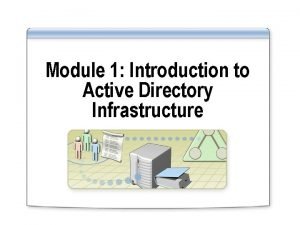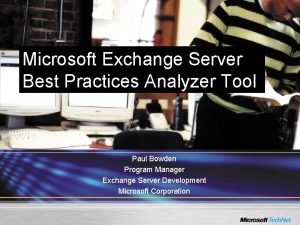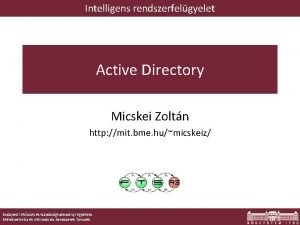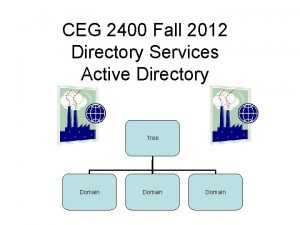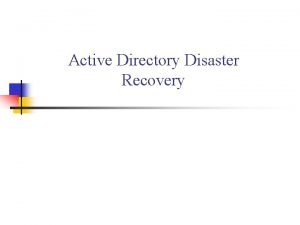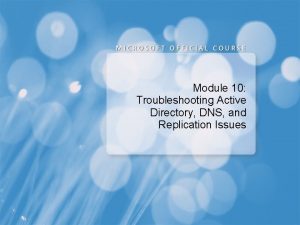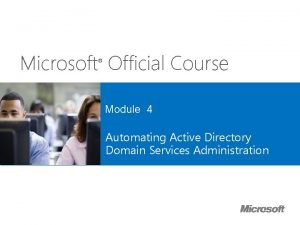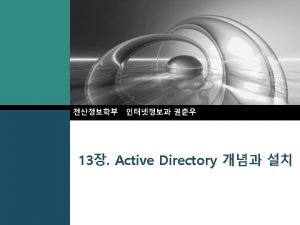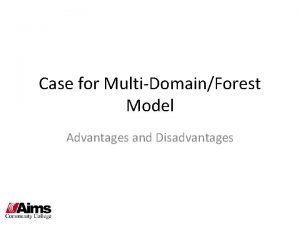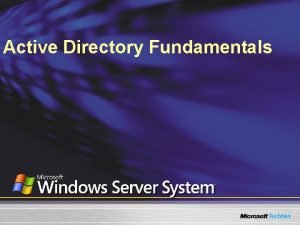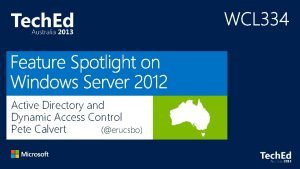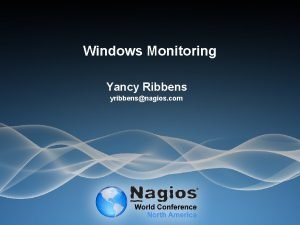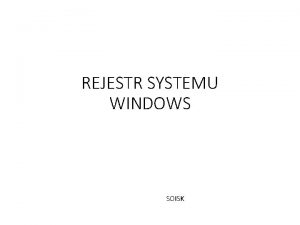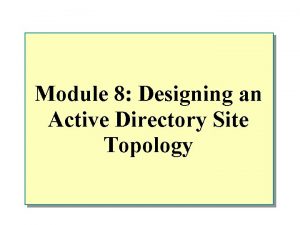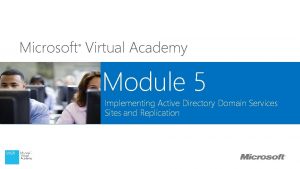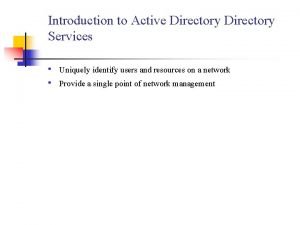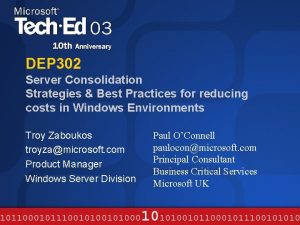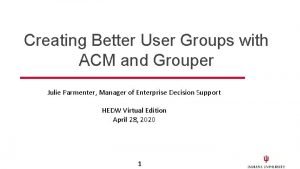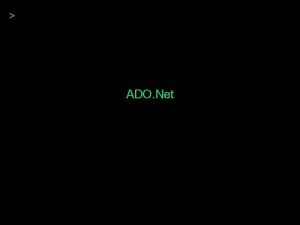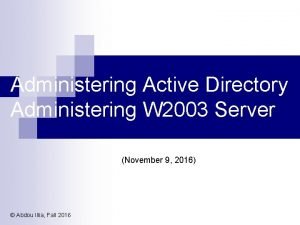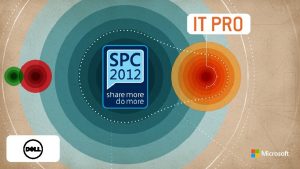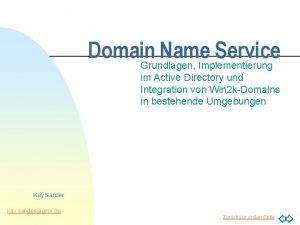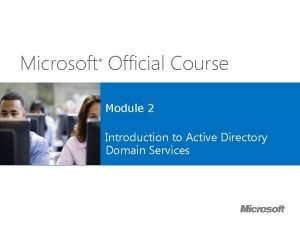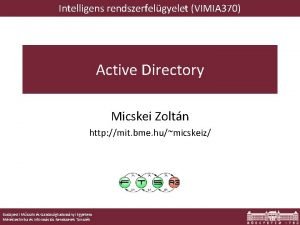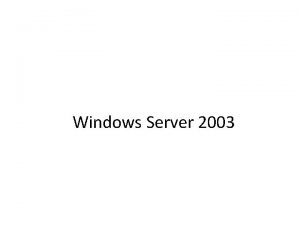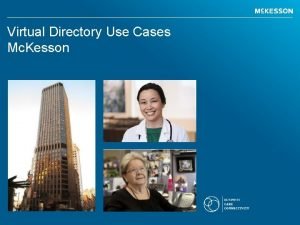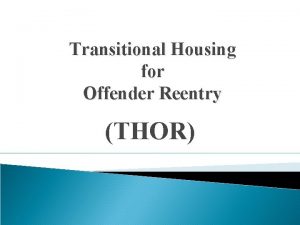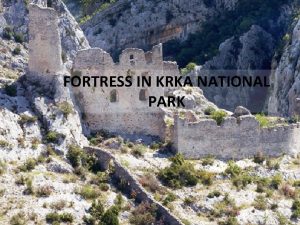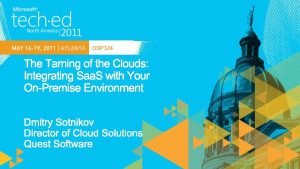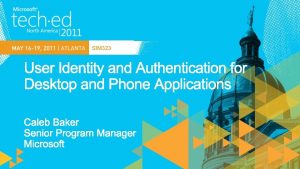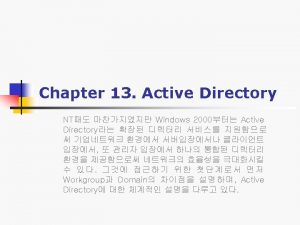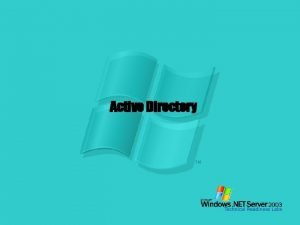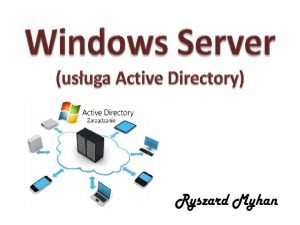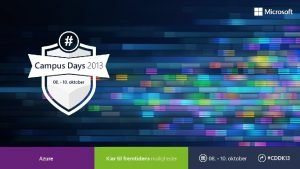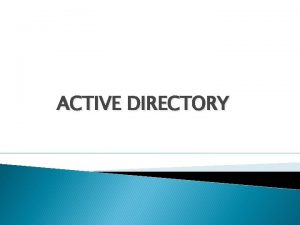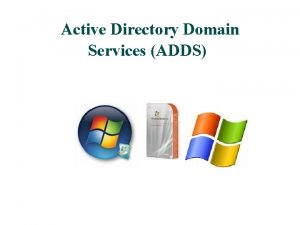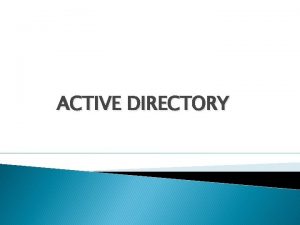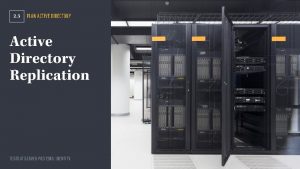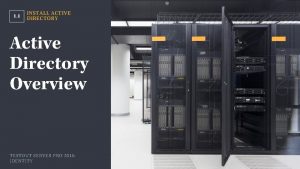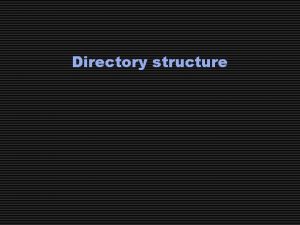Creating a Fortress in Your Active Directory Environment
![Creating a Fortress in Your Active Directory Environment David Rowe @customes david_rowe [@] Harvard. Creating a Fortress in Your Active Directory Environment David Rowe @customes david_rowe [@] Harvard.](https://slidetodoc.com/presentation_image_h/9856fd9f97c9350027856178fde256f1/image-1.jpg)












































![Questions? https: //github. com/davidprowe/AD_Sec_Tools @customes david_rowe [@] Harvard. edu Questions? https: //github. com/davidprowe/AD_Sec_Tools @customes david_rowe [@] Harvard. edu](https://slidetodoc.com/presentation_image_h/9856fd9f97c9350027856178fde256f1/image-46.jpg)

- Slides: 47
![Creating a Fortress in Your Active Directory Environment David Rowe customes davidrowe Harvard Creating a Fortress in Your Active Directory Environment David Rowe @customes david_rowe [@] Harvard.](https://slidetodoc.com/presentation_image_h/9856fd9f97c9350027856178fde256f1/image-1.jpg)
Creating a Fortress in Your Active Directory Environment David Rowe @customes david_rowe [@] Harvard. edu #infosec #blueteam #security © 2019 1



What is Active Directory? Active Directory is a hierarchical structure that stores information about objects on a network • • • Users Computers Groups Dictates security through object ownership and group membership

Why access is important Active directory is set up as a discretionary access control model • Based on the individual • Each person has an account • Accounts have access to objects

Why access is important RBAC • As administrators shift and rotate roles, they create different role groups with different access across the domain(s) • Ex: Helpdesk – reset passwords • Ex: Server Team – log on to servers Privilege creep • Over time accounts gain more and more to objects. • The rights are often overlooked and unknown by owners of AD

Why access is important With users gaining more and more access to objects; computers, groups and other users, attackers have more areas to exploit

For this Presentation - Keep in mind There is a greater number of users on every domain that have privileged access than you can guess User rights, once granted, sit idle and can be used by anyone with access to that account, group, or computer

Cached Creds Defined Computer level setting: Interactive logon: Number of previous logons to cache [store in memory] (in case domain controller is not available) 1 Value indicates stored users credentials on device – (10) Default stored as RC 4 hash on system 2

Cached Creds Vulnerabilities Targeted Pass-the-hash -If you can’t crack it, encapsulate and pass it RC 4 Nomore – one type of RC 4 Exploit – 52 Hrs to crack Rainbow tables –When I was in one incident response team I observed evidence a plaintext password 9 minutes after the hash was compromised

Kerberos • Provides the default authentication services and the authorization data • Necessary for a user to access a resource

Kerberos Policy Encryption Type Server 2000 Win XP Server 2003 DES_CBC_CRC O O X X X DES_CBC_MD 5 O O O X X RC 4_HMAC_ MD 5 O O O O AES 128_HMA C_SHA 1 X X X O O AES 256_HMA C_SHA 1 X X X O O Ref: https: //goo. gl/Ueb. QPs Vista Server 2008 Windows Server 7 2008 R 2

Microsoft’s Solution – ESAE Enhanced Security Administrative Environment • Helps prevent compromise of administrative credentials from cyber-attacks • Thwart attacks by limiting exposure of admin credentials (Cached Credentials) Source:

Microsoft’s Solution – 3 Stages, 14 steps Stage # Step Imp. Cost/Ops Maint Cost 1**** Separate Admin accounts for Workstations $/$ 1**** Separate Admin accounts for Servers $/$ 1**** Separate Admin accounts for Domain Controllers $/$ 2 Privileged Access Workstations for Admins $$/$$$ 2**** Unique Local Passwords for Servers & Workstations $/$ 2 Time Bound Privileges $$/$$$ 2 Just Enough Administration $/$$ 2**** Lower Attack Surfaces of DCs – Limit Admin Count $/$ 2**** Attack Detection $$/$$

Microsoft’s Solution – 3 Stages Stage # Step Imp. Cost/Ops Maint Cost 3* Modernize roles and delegation model to be compliant with the tiers $$/$$ 3 Smartcard authentication for all admins $$$/$ 3 Admin Forest for AD admins $$/$$ 3 Windows Defender Device Guard $$/$$ 3 Shielded VMs $$/$$


1 Day Security Solution

The Breach • An unpatched public facing web server was compromised • An attacker exploited a vulnerability, granting admin access to the server (#5!) • The attacker dumped the cached credentials on the server, finding a local administrator password identical across machines (#4! & #3!) • Attacker moved laterally across the domain probing servers until he/she finds a computer where a domain administrator (DA) credential was stored (#2! & #1!) • Attacker dumps DA hash from machine and cracks it • The attacker now as full administrative access on the domain

#1 Limit Admins – Quick Win

Simple Deploy – 1. Boot People

Built-in Groups’ Rights Overview • Account Operators: Read LAPS attribute, administer domain user and group accounts • Administrators: Complete and unrestricted access • Backup Operators: Override security restrictions for the sole purpose of backing up or restoring files. Allow Logon Locally, log on as batch job, shut down the system • Domain Admins: member of every domain-joined computer’s local Admin group • Enterprise Admins: permissions to change forest-wide configuration settings. Member of every domain’s Administrator group • Group Policy Creator Owners: Can create and modify GPOs on the domain

Built-in Groups’ Rights Overview • Schema Admins: make modifications to the AD Schema • Server Operators: can administer domain servers • Remote Desktop Users: Members of this group can remotely log on to domain controllers in the domain. This group has no default members • Organization Management: This is a RBAC group for MS Exchange Server. Members have admin access to the entire Exchange organization, including modifying membership of other exchange groups

What is a Shadow Admin? shadow admin sensitive privileges. granted directly using ACLs on AD objects. • Attacker steals Field Tech’s Groups where stolen credential has access to modify other objects • Attacker hijacks those objects • Attacker continues to elevate privileges to Tier 0

Finding Shadow Admins

Why find and limit # of admins

#2 Admins – Quick Win

Simple Deploy – 2. Block Admins

Tiered Guidelines Tier 0 Domain Admins Accounts which have the ability to manage identity and permissions enterprise-wide. Objects: Domain Controllers and systems that manage DCs Tier 1 Server Admins Accounts with control over resources or that manage critical data and applications. Objects: Servers Tier 2 Workstation Admins Accounts with administrative privileges over standard user accounts and standard-user devices. Objects: Workstations

Block Admins: The GPO: Servers

Simple Deploy – 3. Cached Creds GPO

Cached Creds: The GPO: Servers

Cached Creds: The GPO: Desktops

Common tools to exploit Cached Creds Mimikatz Jt. R Hashcat Ophcrack Taskmanager… + lsass. exe Pwdumpx + password. Pro

Report on your domain’s cache settings Find machines on the domain that have cached creds enabled *AD_Computer_Cached. CredsFind Computers without Cached Cred GPO. ps 1

Report on your domain’s cache settings

Simple Deploy – 4. LAPS

LAPS

LAPS: Reqs #1 and #2

LAPS: Reqs #3 and #4

Simple Deploy – 5. Audit and Alert

Audit https: //goo. gl/u. GUL 4 a

Alert

Security Tools https: //goo. gl/Ng. Wu. GK

Groups with ACL permissions on Domain *DOMAINIT USERS *DOMAINHR USER MANAGEMENT *DOMAINIT - HELP DESK *DOMAINACCOUNT MANAGEMENT *DOMAINIT Exchange *DOMAINIT User Password Resets *DOMAINIT SERVER ADMINS *DOMAINEnterprise Services *DOMAINOffice dept Admins *DOMAINBase Admins *DOMAINComp Management *DOMAINEMAIL ADMINS *DOMAINCONTACT CREATOR *DOMAINContact. Management *DOMAINCredit_SUPPORT *DOMAINWeb Administration *DOMAINMAILBOX MGMT *DOMAINService Desk *DOMAINO ADMINS *DOMAINVPN Administrators *DOMAINAD User Cleanup *DOMAINRESEARCH ADMINS *DOMAINEpsilon Admins *DOMAINZone ADMINS *DOMAINADWRITERS Admins *DOMAINFile Share ADMINS *DOMAINR drive ADMINS *DOMAINO drive ADMINS *DOMAINSAN Admins *DOMAINMedical APPLICATION ADMINS *DOMAINSERVICE NOW OU ADMINS *DOMAINSERVICE NOW Group ADMINS *DOMAINIT OU ADMINS *DOMAINNetwork Team *DOMAINCluster 2 Admins *DOMAINDatabase Disk Admins *DOMAINCluster Admins

Excessive Group Membership Example: Epic Sunflower
![Questions https github comdavidproweADSecTools customes davidrowe Harvard edu Questions? https: //github. com/davidprowe/AD_Sec_Tools @customes david_rowe [@] Harvard. edu](https://slidetodoc.com/presentation_image_h/9856fd9f97c9350027856178fde256f1/image-46.jpg)
Questions? https: //github. com/davidprowe/AD_Sec_Tools @customes david_rowe [@] Harvard. edu

 Imagery in the crucible act 1
Imagery in the crucible act 1 Hillman fortress
Hillman fortress A mighty fortress is our god
A mighty fortress is our god Dwarf fortress
Dwarf fortress Samba 4 pdc
Samba 4 pdc Golden ticket detection
Golden ticket detection Microsoft privileged access workstation
Microsoft privileged access workstation Active directory design document
Active directory design document Active directory introduction
Active directory introduction Sql best practices analyzer
Sql best practices analyzer Active directory alapok
Active directory alapok Active directory two way trust
Active directory two way trust Active directory disaster recovery best practices
Active directory disaster recovery best practices Active directory replication troubleshooting
Active directory replication troubleshooting Lab 5: manage active directory accounts (module 4)
Lab 5: manage active directory accounts (module 4) Logo active directory
Logo active directory Advantages and disadvantages of active directory
Advantages and disadvantages of active directory Active directory fundamentals
Active directory fundamentals Active directory dynamic access control
Active directory dynamic access control Nagios active directory monitoring
Nagios active directory monitoring Soisk windows 10
Soisk windows 10 Site topology
Site topology Microsoft virtual academy active directory
Microsoft virtual academy active directory Introduction to active directory
Introduction to active directory Active directory consolidation best practices
Active directory consolidation best practices Grouper active directory
Grouper active directory Ado net active directory
Ado net active directory Administering active directory
Administering active directory Gestione utenti active directory
Gestione utenti active directory Active directory cleanup tools
Active directory cleanup tools Active directory
Active directory Active directory grundlagen
Active directory grundlagen Unc active directory
Unc active directory Active directory sites and services
Active directory sites and services Controladores de domínio do active directory
Controladores de domínio do active directory Active directory alapok
Active directory alapok Active directory fundamentals
Active directory fundamentals Creating an english environment
Creating an english environment Write your own declaration
Write your own declaration Financial environment of business
Financial environment of business Active person-environment transaction
Active person-environment transaction 3 to 8 decoder truth table
3 to 8 decoder truth table Primary vs secondary active transport
Primary vs secondary active transport Primary active transport vs secondary active transport
Primary active transport vs secondary active transport Give us your hungry your tired your poor
Give us your hungry your tired your poor Your role in the green environment
Your role in the green environment Identity abstraction layer
Identity abstraction layer Thor approved rehabs
Thor approved rehabs




